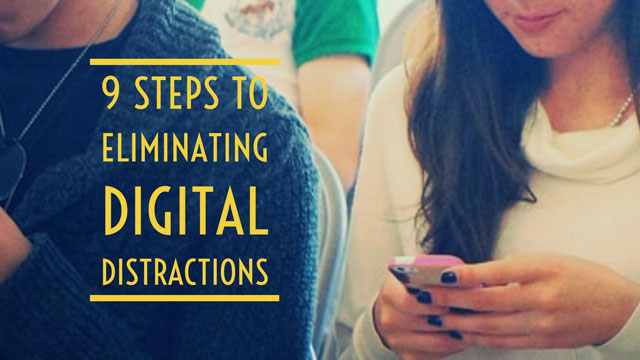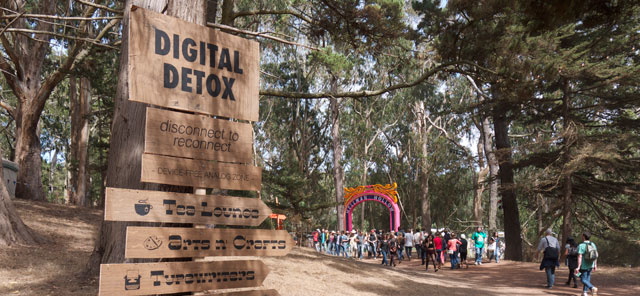
Our smartphones drive us to distraction... literally! A constant stream of dings and buzzes pulls our attention away from whatever we're doing, driving us to check our smartphones. Last year, the average online denizen spent 109 minutes every day using social media—and the amount of time we've been devoting to social media over real life interaction has been on the rise. All of this means we're never focusing on what we're doing and that our attention is constantly pulled away from what's important.
Stepping away from your phone—for an evening, a day, or an entire weekend—can help you sleep better, improve your memory, and even change your posture so you seem more approachable. Returning to work after a weekend unplugged means you show up on Monday morning refreshed and focused on work. That may seem like a lot to gain from just setting aside your phone, but smartphones and social networks have drastically changed how we interact with others—and turning them off can have changes that are just as drastic.
Despite these benefits, most of us have trouble tearing ourselves away from technology. While many of us will look to a vacation as a chance to unplug, more than half—55%, according to a study by Intel Security—don't. And if you're checking work emails on your vacation, just how much are you actually enjoying that vacation? A few seconds to glance at your smartphone might not seem like much, but it's pulling you away from friends, family, and fun—which isn't ideal for a vacation. Getting away from the distractions of home and work should make a vacation the easiest time to unplug. If most of us can't even manage that, how are we supposed to escape in our daily lives?
It isn't easy, which is precisely why there are a growing number of no-smartphones-allowed retreats centered around digital detox. But even if you aren't ready to commit to a retreat, you can still dial down the digital distractions in your everyday life if you're willing to make the effort.
9 Steps to dialing down on distractions
Even if you don't completely unplug, there are lots of ways you can reduce the number of everyday distractions you deal with. Even though this is a long way from a full detox, a few simple changes in how you use your gadgets can make a big difference. Here's where to start.
1. Turn off notifications
Some of the notifications you get on your smartphone are important... but a lot of them aren't. Go through your notification settings and turn off unimportant notifications (we show you how here). Now your phone will only bother you when something you actually care about is happening.
2. Configure your email to only notify you of important messages
Chances are you get a lot of digital junk mail. And chances are you don't need your phone to buzz whenever that happens. Fortunately, most mail clients can be configured to notify you when you have important emails, but leave you alone about everything else (we show you how here).
3. Unsubscribe to unwanted emails
Some of the junk mail you get probably includes newsletters you signed up for or stores you shopped at once that now email you weekly. None of us need all of this email, but it can be a real nuisance to unsubscribe. If you're a Gmail user, you'll find an unsubscribe button to the right of the sender's name—just click and Gmail will handle the rest. Outlook has a similar feature: look for its unsubscribe button at the bottom of the message window.
4. Combine multiple messages into a single digest
Even when you're getting overloaded by email, you may not want to unsubscribe to everything. In that case, consider another useful feature of Unroll.me: the ability to take all of your email subscriptions and combine them into one daily email. Now instead of a dozen emails a day, you'll only get one.
5. Just sign out
When you're trying to focus on something—whether work or play—take a minute to sign out of all of your social networking and messaging apps. Log out of Facebook, close Twitter and shut down your email client. Now you can get things done without the constant distraction of a new message notification.
6. Tell your phone to go to sleep when you do
The easiest way to do this is to switch your phone off—or at least into airplane mode—when it's bedtime, but both iPhone and Android will let you set a schedule where they'll mute notifications overnight. Look for Do Not Disturb under settings for iPhone and Android 5.0 and higher.
7. Remind yourself to step away from tech
Time Out for Mac OS and EyeLeo for Windowswill both remind you to take short breaks during the day to get away from your computer. If you happen to be in the market for a fitness tracker or smartwatch, the Fitbit Alta ($123on Amazon), Jawbone Up3 ($67 on Amazon) and Apple Watch ($299on Amazon) will remind you when you've been sitting still too long and should get away from your desk and move.
8. Lock down your screentime
If you can't do it yourself, you can get an app that will lock your gadget down so you have to unplug. Screentime and Offtime apps for both iPhone and Android allow you to set customized smartphone schedules for when—and how long—you can use different apps. Screentime is designed for families and has parental controls in mind—but it works just as well for both kids and adults—while Offtime is aimed specifically at adults trying to get away from distractions and be more productive. Another option designed for parental controls—but good for anyone who's looking for less screentime—is Disney Circle ($99 on Amazon). Circle sets limits on screentime and app usage for every device that connects to your home network.
9. Don't check your phone at bedtime
The bright blue light from the screens can have a negative impact on your sleep—and whatever you read might not be conducive to restful sleep, either. So do yourself a favor: set your phone on the bedside table and leave it there all night.
Do it yourself digital detox
If you want to go further than fewer digital distractions, it's time to give full-scale detoxing a try. That can be as simple as hitting the power switch on your phone, tablet and computer. You can decide to do it for an evening, a weekend or an entire vacation—just be realistic on what works with your schedule so you aren't trying to unplug just to get an emergency phone call from the office. Once you've committed to your digital-free downtime, though, the hard part is not answering the siren song of technology. While firing up your computer to check your email may only take a minute, that's a minute you could be focusing on doing something you really want to be doing. To make a detox work, you'll have to keep reminding yourself that the goal is to have space to relax and have fun, distraction-free.
Let's walk through just how to create your own digital detox retreat at home.
Decide when you're going to unplug
Be sure you aren't setting yourself up for failure! Be sure whatever time you choose doesn't clash with a major deadline at work or another event that might pull your attention to your technology.
Tell people you’re unplugging
Tell your family, friends, co-workers and even clients that you won't be available. This means no one should be trying to bother you—and, hopefully, that no one will take drastic measures (like calling your spouse) to try to find out where you are.
Turn everything off and put it away
Our gadgets are scattered all over the house. Before your detox, it's a good idea to collect them, power them down, and put them away so they won't tempt you.
Plan something to do
Remember, you're unplugging so you can fully focus on something you enjoy. That could mean inviting friends over for dinner, spending a day at the lake or even relaxing at home with a good book. Having something to do will keep you from staring at your phone and wondering what's happening on the other side of the digital divide.
Take a detox vacation

If you want to unplug but you're having trouble with the DIY method, there are vacations and retreats with a digital detox philosophy. One of them is certain to fit your interests and budget.
Intrepid Travel Digital Detox Tours (starting at $630)
The Intrepid Travel touring company offers four "digital detox" tours that require you to sign a pledge committing to a trip free of internet, Wi-Fi, cellphones, laptops and even cameras. Detox itineraries are offered for Ecuador, India, Morocco, and Thailand.
Camp Grounded (starting at $645)
Camp Grounded camp for adults holds events across the country that feature activities from archery to creative writing (word processor free, of course). Just like summer camp when you were a kid, you'll be sleeping in shared cabins with bunk beds and there will be evening campfires and s'mores. Unlike summer camp when you were a kid, there's daily yoga and gourmet food. Low income tickets are available for a reduced price.
The Ranch at Live Oak Malibu (starting at $6,800)
If you want to go all out, the Ranch at Live Oak Malibu luxury bootcamp will take you off the grid and help you towards a healthier lifestyle with fitness classes and an all-organic vegetarian menu. The minimum stay is a week which will set you back $6,800. It's a hefty price tag, but perhaps a week of no-distraction luxury is worth it!
[Image credits: Digital Detox by DavityDave / CC BY, Smartphones by Esther Vargas / CC BY]













From James on March 30, 2018 :: 10:33 am
Over year ago I started using Kidslox (https://kidslox.com/). This a good instrument for time management. I set time limits for my kid for every day and they know the rules. If the granted time runs out, they just put away their devices and help us with family tasks or do their personal tasks. I think all parents need to install similar apps. They really help!
Reply